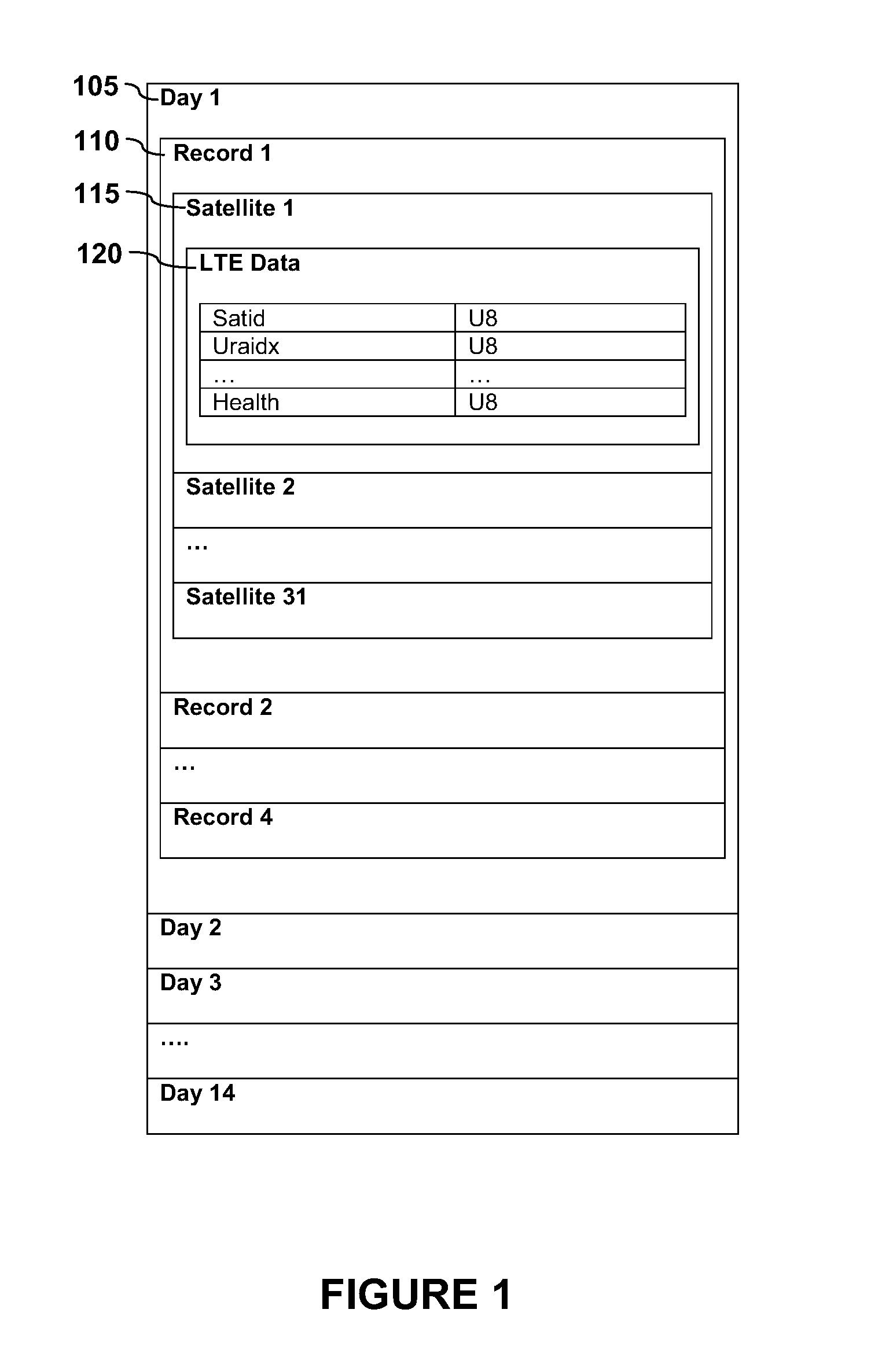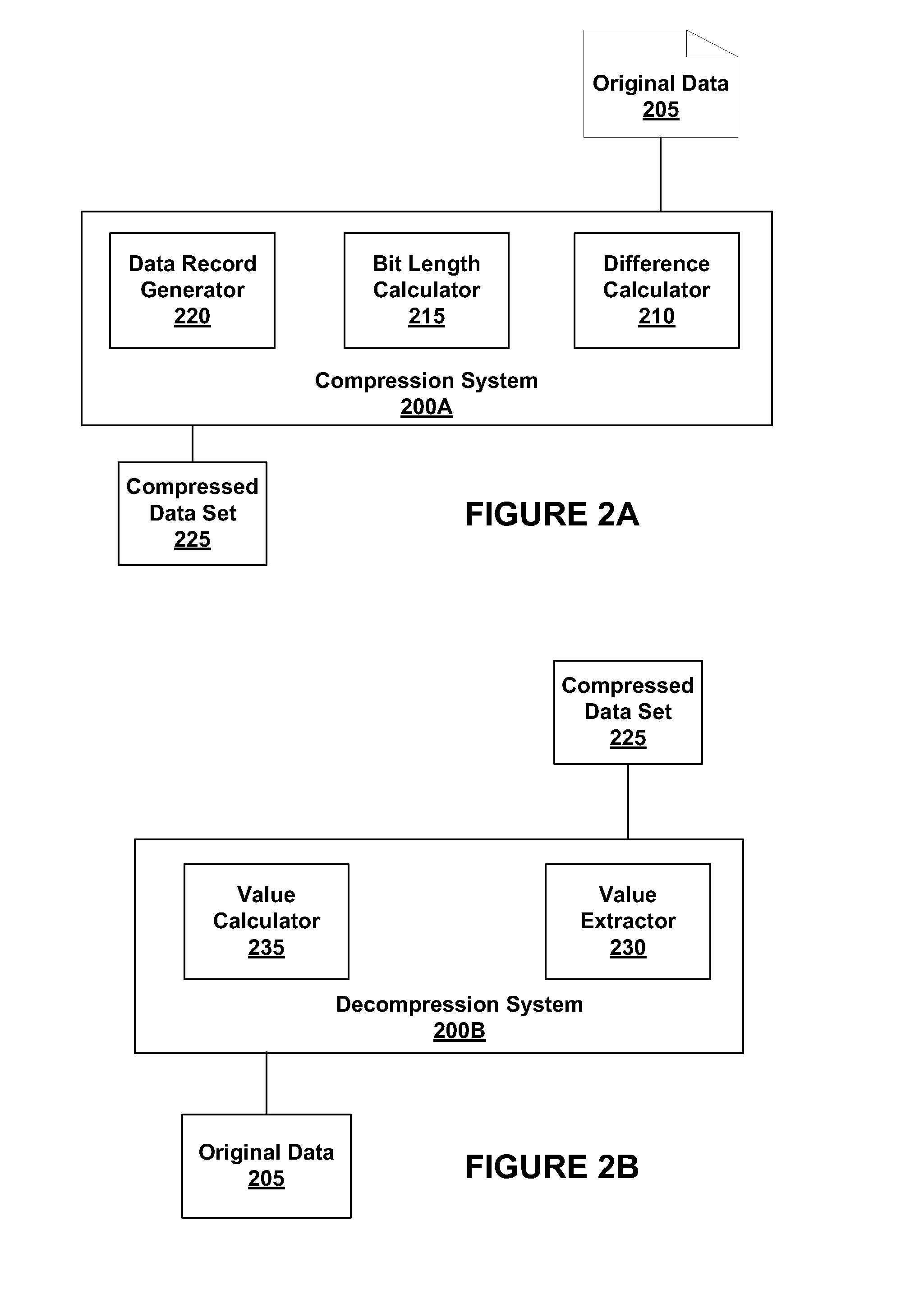Data Compression by Multi-Order Differencing
- Summary
- Abstract
- Description
- Claims
- Application Information
AI Technical Summary
Benefits of technology
Problems solved by technology
Method used
Image
Examples
first embodiment
1. a Method for Compression of Data
[0076]FIG. 4 depicts a method 400 for compressing data 205 according to various embodiments of the invention. An exemplary set of 56 data values 205 is associated with the GPS parameter “health” (See Table 1). Each of the data values associated with “health” has a value of either 0 or 1 and often the values within the set of values are constant.
[0077]In embodiments, an original value is designated 405 as a first reference value. A set of first-order difference values is calculated 410 between neighboring original values according to the following equation:
Di1=Di0−Di−10, i=2, . . . ,56 (1)
[0078]where Di0 is the ith original value, and Di1 is the ith first-order difference. In this example, D10 is designated as the first reference value.
[0079]The bit length Bj to encode the difference values for order j is calculated 415 according to the following equation:
Bj={ceil(log2(max(Dj)+1))+1,max(Dj)>00,max(Dj)=0(2)
[0080]For a first-order difference, j=1...
second embodiment
2. a Method for Compression of Data
[0082]FIG. 5 depicts a method 500 for compressing data 205 according to various embodiments of the invention. The method depicted in FIG. 5 may be used for data in which the values are small and distributed within a tight cluster. An exemplary set of 56 data values 205 is associated with the GPS parameter “uraidx” (See Table 1).
[0083]In embodiments, an original value is designated 505 as a first reference value. A set of first-order difference values is calculated 510 between neighboring original values according to Equation (1) as previously discussed.
[0084]A first-order difference value is designated 515 as a second reference value (e.g., D21), and a set of second-order differences is calculated 520 between neighboring first-order difference values according to the equation
Di2=Di1−Di−11, i=3, . . . ,56 (3)
[0085]In embodiments, the first reference value bit length is 8 bits because the maximum value of the parameter “uradix” is one byte. Alterna...
third embodiment
3. a Method for Compression of Data
[0088]FIG. 6 depicts a method 600 for compressing data 205 according to various embodiments of the invention. The method depicted in FIG. 6 may be used for data in which the values are distributed within straight line segments having different magnitudes. An exemplary set of 56 data values 205 is associated with the GPS parameter “omega0” (See Table 1).
[0089]In embodiments, an original value is designated 605 as a first reference value. A set of first-order difference values is calculated 610 between neighboring original values according to Equation (1) as previously discussed.
[0090]Since each line segment is almost straight, only one first-order difference value may be designated 615 as a second reference value D21, and a set of second-order differences is calculated 620 between neighboring first-order difference values according to Equation (3) as previously discussed.
[0091]In embodiments, a second-order value difference bit length is calculated ...
PUM
 Login to View More
Login to View More Abstract
Description
Claims
Application Information
 Login to View More
Login to View More - R&D
- Intellectual Property
- Life Sciences
- Materials
- Tech Scout
- Unparalleled Data Quality
- Higher Quality Content
- 60% Fewer Hallucinations
Browse by: Latest US Patents, China's latest patents, Technical Efficacy Thesaurus, Application Domain, Technology Topic, Popular Technical Reports.
© 2025 PatSnap. All rights reserved.Legal|Privacy policy|Modern Slavery Act Transparency Statement|Sitemap|About US| Contact US: help@patsnap.com



